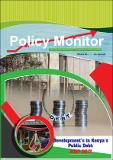| dc.date.accessioned | 2020-11-25T09:56:00Z | |
| dc.date.available | 2020-11-25T09:56:00Z | |
| dc.date.issued | 2018 | |
| dc.identifier.uri | http://repository.kippra.or.ke/handle/123456789/2280 | |
| dc.description.abstract | During this Quarter, the institute engaged stakeholders in various forums including Policy seminars, dissemination workshops and the Launch of KIPPRA Mentorship Programmes for Universities. Kenya’s economic growth during the 2nd quarter of 2018 remained impressive given the stable macroeconomic environment, adequate foreign exchange reserves, low interest rates and favorable weather conditions during the March-May Long rains. However, imports of goods continued to rise during the quarter while introduction of 8% VAT on petroleum products exerted pressure on other related products. | en |
| dc.language.iso | en | en |
| dc.publisher | The Kenya Institute for Public Policy Research and Analysis (KIPPRA) | en |
| dc.relation.ispartofseries | Policy Monitor;Issue 10 No. 1 July-September 2018 | |
| dc.subject | Public Expenditure | en |
| dc.subject | Public Debt | en |
| dc.subject | Interest Rate Capping | en |
| dc.subject | Trade Imbalance | en |
| dc.subject | Macroeconomic Stability | en |
| dc.subject | Macroeconomic Environment | en |
| dc.title | Policy Monitor, Issue 10 No. 1, July-September 2018 on Development's in Kenya's Public Debt 2007-2017 | en |
| dc.type | KIPPRA Publications | en |
| ppr.contributor.author | Kenya Institute for Public Policy Research and Analysis (KIPPRA) | en |

